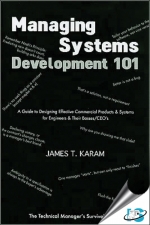Tab Article
This book provides specific, practical advice for engineers who are advancing beyond their technical specialty and find themselves working with other specialties necessary to the development of a complex system or product. They continually face a variety of issues that were invariably never addressed in their schooling: dealing with specifications, project plans, and budgets; improving quality by working with "downstream" functions such as production and service; resolving incompatibilities and bugs under a variety of test conditions; providing technical direction and reviews; and more.
Based on "lessons learned" by the author over a forty-year career developing complex systems products, the book presents basic principles that are applicable whether you are in a bureaucratic, multi-national corporation or one with the founder still in control. Regardless of an organization's size or the particular products, the engineering management issues are eerily the same. Systems are systems, and the engineering process basics, derived largely from aerospace, remain the key to success anywhere. Chapter titles typically end in "101" because the basics are usually where the problems lie, as well as their solutions. This book is concise, but the content is dense. As such, it will also provide a succinct refresher for more experienced professionals and their management when facing challenges.


